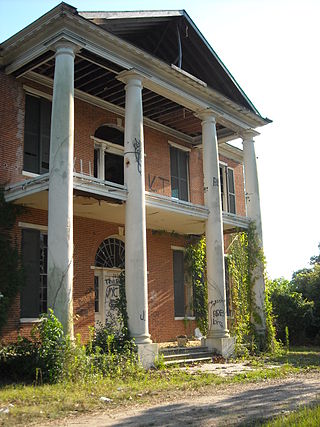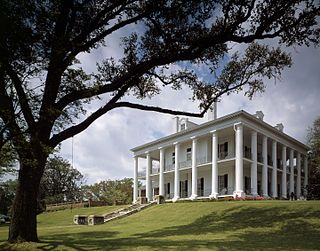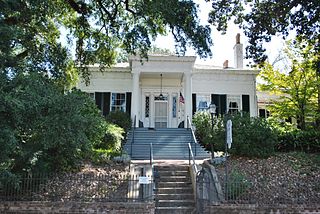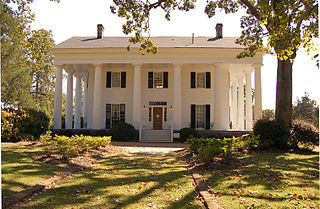
Longwood, also known as Nutt's Folly, is a historic antebellum octagonal mansion located at 140 Lower Woodville Road in Natchez, Mississippi, United States. Built in part by enslaved people, the mansion is on the U.S. National Register of Historic Places, and is a National Historic Landmark. Longwood is the largest octagonal house in the United States.

Gaineswood is a plantation house in Demopolis, Alabama, United States. It is the grandest plantation house ever built in Marengo County and is one of the most significant remaining examples of Greek Revival architecture in Alabama.

Arlington is a historic Federal style house and outbuildings in Natchez, Mississippi. The 55-acre (22 ha) property, which includes three contributing buildings, was listed on the National Register of Historic Places in 1973. It was further declared a National Historic Landmark in 1974. Following a fire that destroyed much of the main house, it was placed on Mississippi's 10 most endangered historic places for 2009 by the Mississippi Heritage Trust.

Auburn is an antebellum mansion in Duncan Park in Natchez, Mississippi. It was designed and constructed by Levi Weeks in 1812, and was the first building to exhibit Greek Revival order in the town. Its prominent two-story Greek portico served as a model for the subsequent architectural development of local mansions. It was declared a National Historic Landmark in 1974 and a Mississippi Landmark in 1984.

The Commercial Bank and Banker's House is an unusual combination building, housing both a bank premises and the principal banker's residence, at 206 Main Street and 107 Canal Street in Natchez, Mississippi. Built-in 1833, it is a remarkably high-quality and well-preserved example of Greek Revival architecture. It was designated a National Historic Landmark in 1974. The bank portion of the building, used for a time by a Christian Science congregation, is presently vacant, while the house portion is a private residence. Both the buildings have carved limestone used extensively, columns lintels, window sills, and the entire facia are all carved limestone with the walls being 20" thick brick construction with scored plaster to have the appearance of large limestone blocks.

Dunleith is an antebellum mansion at 84 Homochitto Street in Natchez, Mississippi. Built about 1855, it is Mississippi's only surviving example of a plantation house with a fully encircling colonnade of Greek Revival columns, a form once seen much more frequently than today. Now an inn and conference center, it was designated a National Historic Landmark in 1974. Currently the original horse stable serves as a fine dining establishment with a traditional English pub in the lower levels of the structure

Charles McLaran House, also known as Riverview and as Burris House, is a historic mansion at 512 Second Street South in Columbus, Mississippi. Built in 1847 for a major local landowner, it is a distinctive and particularly grand and well-preserved example of Greek Revival architecture. It was declared a National Historic Landmark in 2001.

Belmont Mansion, also known as Acklen Hall, and originally known as Belle Monte, Belle Mont or Belmont, is a historic mansion located in Nashville, Tennessee. It was built by Joseph and Adelicia Acklen to serve as the center of their 180-acre summer estate in what was then country outside the city, and featured elaborate gardens and a zoo. They lived much of the rest of the year on her plantations in Louisiana.

Melrose is a 15,000 square feet (1,400 m2) mansion, located in Natchez, Mississippi, that is said to reflect "perfection" in its Greek Revival design. The 80-acre (320,000 m2) estate is now part of Natchez National Historical Park and is open to the public by guided tours. The house is furnished for the period just before the Civil War. Melrose was declared a National Historic Landmark in 1974.

Monmouth is a historic antebellum home located at 1358 John A. Quitman Boulevard in Natchez, Mississippi on a 26-acre (11 ha) lot. It was built in 1818 by John Hankinson, and renovated about 1853 by John A. Quitman, a former Governor of Mississippi and well-known figure in the Mexican–American War. It is one of Natchez's grandest Greek Revival mansions. It was declared a Mississippi Landmark in 1986 and a National Historic Landmark in 1988. It is now a small luxury hotel.

Rosalie Mansion is a historic pre-Civil War mansion and historic house museum in Natchez, Mississippi. Built in 1823, it was a major influence on Antebellum architecture in the greater region, inspiring many of Natchez's grand Greek Revival mansions. During the American Civil War, it served as U.S. Army headquarters for the Natchez area from July 1863 on. It was designated a National Historic Landmark in 1989.

"Green Leaves", also known as the Koontz House or the Beltzhoover House, is a Greek Revival mansion in Natchez, Mississippi, completed in 1838 by Edward P. Fourniquet, a French lawyer who built other structures in the area. It was purchased by George Washington Koontz, a local banker in 1849 and has been owned by his descendants ever since. It was listed on the National Register of Historic Places (NRHP) in 1979.

The Burn, a house built in 1834, is the oldest documented Greek Revival residence in Natchez, Mississippi. It was built on a knoll to the north of the old town area of Natchez. It was listed on the National Register of Historic Places in 1979.

Sturdivant Hall, also known as the Watts-Parkman-Gillman Home, is a historic Greek Revival mansion and house museum in Selma, Alabama, United States. Completed in 1856, it was designed by Thomas Helm Lee for Colonel Edward T. Watts. It was added to the National Register of Historic Places on January 18, 1973, due to its architectural significance. Edward Vason Jones, known for his architectural work on the interiors at the White House during the 1960s and 70s, called it one of the finest Greek Revival antebellum mansions in the Southeast.

Antebellum architecture is the neoclassical architectural style characteristic of the 19th-century Southern United States, especially the Deep South, from after the birth of the United States with the American Revolution, to the start of the American Civil War. Antebellum architecture is especially characterized by Georgian, Neo-classical, and Greek Revival style homes and mansions. These plantation houses were built in the southern American states during roughly the thirty years before the American Civil War; approximately between the 1830s to 1860s.

The United States Courthouse, previously known as Institute Hall, Opera Hall, and Memorial Hall, is a building in Natchez, Mississippi that was initially constructed from 1851 to 1853, for use as an educational building. It has served a variety of public purposes in the intervening years. It was listed on the National Register of Historic Places in 1979. In 2007, it was rededicated as a courthouse of the United States District Court for the Southern District of Mississippi.

The Reuben Davis House, also known as Sunset Hill, is a U.S. national historic place located in Aberdeen, Mississippi. It is an impressive two-story antebellum mansion that was constructed between 1847 and 1853. Well known as the former residence of Reuben Davis, a prominent attorney, statesman, and author, the property has important historical connections for both the town of Aberdeen and Mississippi.

Cherry Grove Plantation is a historic plantation in Natchez, Mississippi.

Lansdowne is a historic mansion that is listed on the National Register of Historic Places in Natchez, Adams County, Mississippi. It was originally built as the owner's residence on the 727-acre, antebellum, Lansdowne Plantation. The mansion and 120 acres are still owned and occupied by the descendants of the builder, who open it periodically for tours.

Homewood Plantation was a historic plantation with a mansion of the same name located on it in Natchez, Adams County, Mississippi. Built in 1860 as a wedding present for the Southern belle Catherine Hunt, the daughter of millionaire planter David Hunt, the mansion remained unscathed during the American Civil War of 1861-1865. By the early twentieth century, it was used as a shooting location for 1915 classic film The Birth of a Nation. The author Stark Young used Homewood as the setting of a wedding in his 1934 novel So Red the Rose. The mansion burnt down in 1940.























